Improving properties of h-BN/GH4169 self-lubricating composites prepared using nickel coated h-BN powders
IF 2.4
4区 材料科学
Q3 MATERIALS SCIENCE, COMPOSITES
引用次数: 0
Abstract
ABSTRACT The service conditions of high temperature and heavy load of aero-engine require high-temperature self-lubricating composites with high strength, low wear and long life. Hence, the high-level objective of this study is to regulate the interface between the substrate and hexagonal boron nitride (h-BN) lubricant in GH4169 nickel-based high-temperature self-lubricating composites to improve the interfacial bonding strength and the overall performance. Electroless plating method was adopted to coat nickel on h-BN, and the dense high-temperature self-lubricating composites were fabricated through hot-pressing sintering. The effects of nickel coating on h-BN on the microstructure, mechanical properties and high-temperature tribological behaviors of composites were analyzed in detail, and the lubrication mechanism was also elucidated. The results illustrate the Ni@h-BN/GH4169 composites with addition of chemically modified lubricant particles have excellent mechanical properties and lubrication and wear reduction properties, compared to h-BN/GH4169 composites. This is mainly due to the introduction of nickel coating contributed to the distribution uniformity of h-BN in the matrix, and the wettability between h-BN and the substrate together with interfacial bonding strength were enhanced as well. This work provides an insight to overcome the challenges facing the technology when using GH4169 nickel-based self-lubricating composites in manufacturing of mechanical components in aerospace.改善镀镍h-BN粉末制备的h-BN/GH4169自润滑复合材料性能
航空发动机的高温重载工况要求高强度、低磨损、长寿命的高温自润滑复合材料。因此,本研究的高层次目标是调节GH4169镍基高温自润滑复合材料中基体与六方氮化硼(h-BN)润滑剂之间的界面,以提高界面结合强度和整体性能。采用化学镀法在h-BN表面镀镍,采用热压烧结法制备致密高温自润滑复合材料。详细分析了镀镍对h-BN复合材料显微组织、力学性能和高温摩擦磨损性能的影响,并阐明了其润滑机理。结果表明,与h-BN/GH4169复合材料相比,添加化学改性润滑油颗粒的Ni@h-BN/GH4169复合材料具有优异的力学性能和润滑减磨性能。这主要是由于镍涂层的引入使得h-BN在基体中的分布更加均匀,h-BN与基体之间的润湿性增强,界面结合强度增强。这项工作为克服在航空航天机械部件制造中使用GH4169镍基自润滑复合材料所面临的技术挑战提供了见解。
本文章由计算机程序翻译,如有差异,请以英文原文为准。
求助全文
约1分钟内获得全文
求助全文
来源期刊

Composite Interfaces
工程技术-材料科学:复合
CiteScore
5.00
自引率
3.80%
发文量
58
审稿时长
3 months
期刊介绍:
Composite Interfaces publishes interdisciplinary scientific and engineering research articles on composite interfaces/interphases and their related phenomena. Presenting new concepts for the fundamental understanding of composite interface study, the journal balances interest in chemistry, physical properties, mechanical properties, molecular structures, characterization techniques and theories.
Composite Interfaces covers a wide range of topics including - but not restricted to:
-surface treatment of reinforcing fibers and fillers-
effect of interface structure on mechanical properties, physical properties, curing and rheology-
coupling agents-
synthesis of matrices designed to promote adhesion-
molecular and atomic characterization of interfaces-
interfacial morphology-
dynamic mechanical study of interphases-
interfacial compatibilization-
adsorption-
tribology-
composites with organic, inorganic and metallic materials-
composites applied to aerospace, automotive, appliances, electronics, construction, marine, optical and biomedical fields
 求助内容:
求助内容: 应助结果提醒方式:
应助结果提醒方式:


